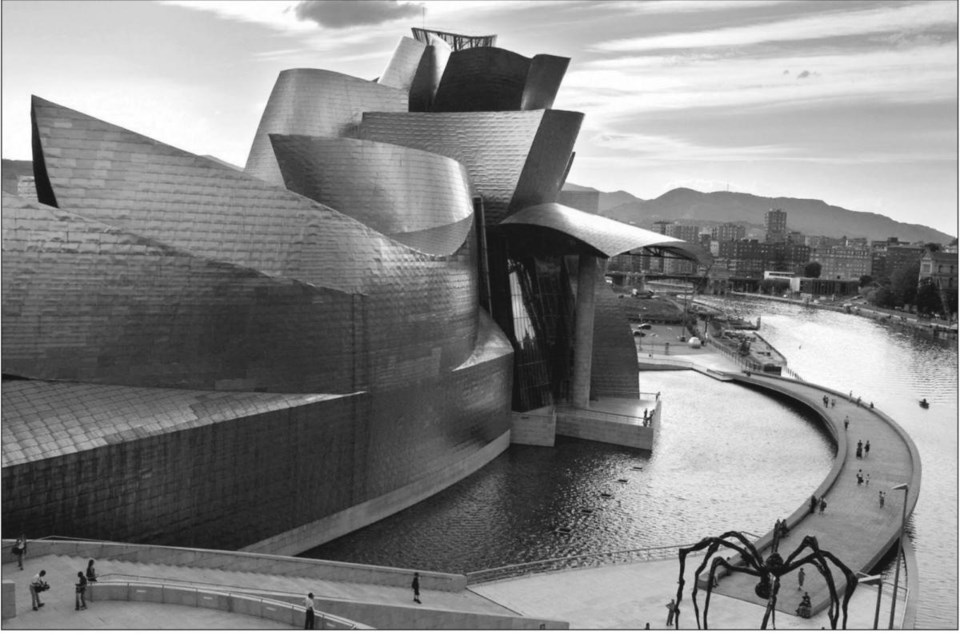A giant topiary terrier, a museum clad in steel scales, old-world elegant avenues and pine and palm trees swaying against dramatic dark hills are just some of the sights of Bilbao in northern Spain.
About an hour's flight from Madrid, Bilbao sits inland from the Bay of Biscay. Signs appear in both Basque and Castilian Spanish but people speak fluent Castilian and many are quite comfortable switching to English.
Even with about a million inhabitants, Bilbao retains plenty of old-fashioned charm. Dainty 19th-century apartment blocks line the avenues leading down to the Ria de Bilbao, the once-polluted river that now is one of the city's most attractive features.
Many residential buildings feature delicate wrought-iron railings and glassed-in balconies that seem to be almost unique to the north of Spain, where lower temperatures and fewer hours of sunlight mean its residents must do more to conserve warmth, especially during the long, dark winter months.
FRIDAY
5 p.m. Start off in Plaza Moyua, which boasts two of the famous shell-like glass and steel entrances to its subway system, known as "fostercitos," for their designer, British architect Norman Foster.
The centre of the plaza is a pedestrian square, decked clusters of the white begonias and red impatiens that feature in most flowerbeds around town, evoking the colours of the "ekuri脙卤a," the green, red and white Basque flag that flutters outside most public buildings.
Walk down Alameda Recalde to the Guggenheim art museum, which is guarded by "Puppy," a five-storey-high West Highland terrier statue made entirely of pink, orange, yellow, purple and white flowers, designed by American artist Jeff Koons.
Admire the shimmering asymmetrical steel sweeps of the walls of the Guggenheim, which this year celebrates its 50th anniversary. For 13 euros ($16) visitors can tour the museum's entire collection, which includes visiting exhibitions.
8 p.m. Wander down to the riverfront to the Campa de los Ingleses, or "Ingelesen Landako" in Basque, the park named for the many English engineers who flocked to Bilbao in its 19th-century heyday to bring their know-how to the steel and shipbulding industries.
Enjoy a cold beer and some live music at one of the open-air terraces, before making your way back into town.
10 p.m. Walk up Calle Iparraguirre, which is dotted with small restaurants and caf脙漏s, where you can grab a quick drink and a "pintxo," or snack.
Tortilla, the traditional Spanish omelette made with potatoes and onions takes a new twist here. The Basques like to add a few personal touches to their snacks, and to tortilla in particular. Don't be surprised to be offered anything from the plain vanilla variety to a tortilla layered with crabmeat, mayonnaise, topped with cheese and, finally, a slice of ham omelette on the top.
But don't expect much in the way of dinner before this time of day. Spanish eating habits die hard and the later, the better.
SATURDAY
10 a.m. Have some breakfast at your hotel to start the day. Walk south down Calle Elcano, turn right into Alameda de Urquijo and to Plaza Indautxu, named for the affluent neighbourhood where it is located. Caf脙漏s line the square, which is paved with brilliant white stone. It is an easy stroll to the river, which bears a few of the remnants of Bilbao's past as a grimy industrial hub, before its metamorphosis into a buzzing cultural metropolis.
Noon. Wander down to the riverfront, past the Palacio Ibaigane, the turn-of-the-century stone palace belonging to the Athletic de Bilbao football team.
Along the way, you'll see the Zubi Zuri footbridge.
Zubi Zuri, which in Basque means "white bridge," is a suspension bridge paved with translucent glass bricks. It was designed by Spain's Santiago Calatrava to offer easy pedestrian access to the Guggenheim from the opposite side of the river.
2 p.m. Time for lunch. A walk back through Indautxu will lead to any number of restaurants which offer a three-course menu del dia for a modest price. Basque fare tends to be simple - roast chicken, fresh grilled fish, plenty of green salad and pisto bilbaino, a delicious vegetarian dish.
In the afternoon, a siesta is common as restaurants wind down from the lunchtime trade and the shops close for a couple of hours.
6 p.m. For a spot of postsiesta shopping, head east along the Gran Via de Lopez de Haro, a wide, tree-lined boulevard where you will find Spanish high street retailer Zara alongside luxury outlets such as Hugo Boss or Louis Vuitton.
From the main drag walk through the picturesque Parque de Do脙卤a Casilda Iturrizar, named for the benefactress who donated the land to the city. The park features a duck pond and a wisteria-covered pergola.
9 p.m. For a taste of the real Bilbao, cross the river into the modest suburb of Deusto and savour a glass of "txakoli" at any of the neighbourhood bars. Enjoy the crisp, cool white wine, grown exclusively in the Basque Country, with a slice of layered tortilla.
The bars in this part of town are devoted to Athletic de Bilbao, which reached the UEFA cup football final before losing to Madrid rival Atletico. Before heading back to the centre, take a stroll along the Deusto bank of the river to enjoy the view of the city.
Visit Casco Antiguo, the old town, with its dark, gold stone buildings and narrow winding streets. The crowd tends to be twenty-somethings, but as with anywhere in Spain, in Bilbao there is something for everyone.
SUNDAY
11 a.m. Sleep in after a late night and enjoy a cafe con leche with a "bollo bilbaino," a sweet bun filled with sweetened whipped butter, before enjoying one last wander along the river before bidding farewell to the city and heading to the airport.



